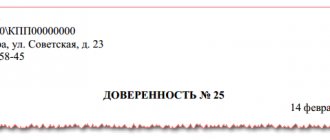Why do you need an order for the right to sign?
The Ministry of Finance of the Russian Federation in information dated December 4, 2012 No. PZ-10/2012, commenting on the provisions of the Law “On Accounting” dated December 6, 2011 No. 402-FZ, expressed the opinion that the head of an economic entity is obliged to approve lists of persons who are authorized to sign primary accounting documents.
The position of the department is based on the provisions of Art. 7 and 9 of Law No. 402-FZ and can be considered as defining a successive rule of law relative to the one established in paragraph 3 of Art. 9 of the Law “On Accounting” dated November 21, 1996 No. 129-FZ, which was previously in force. The previous legal acts regulating accounting contained a direct requirement for the manager to approve the list of persons who have the right to sign on the primary document.
The current legislation does not regulate how the relevant persons should acquire their powers. In practice, in Russian organizations it is common to consolidate these powers by issuing by management:
- an order for the right to sign the primary document by a specific person or a list of persons;
- power of attorney for the right to sign the primary document.
Let us consider the specifics of both methods of transferring rights to sign a primary document in more detail.
Facsimile signature on primary documents
Some managers believe that it is not necessary to give employees the right to sign documents - you can simply use a facsimile instead of your own signature. According to the Civil Code, facsimiles can be used in cases and in the manner provided for by law, other legal acts or agreement of the parties. However, the use of facsimiles specifically on primary documents is a controversial issue: regulatory authorities believe that the use of facsimiles when preparing primary documents is unlawful. Despite the fact that there have been cases when judicial practice proves the opposite point of view on this issue, nevertheless, if you do not want controversial issues to arise, it is better not to use a facsimile.
How to certify the right to sign primary documents - by order or power of attorney
The main criterion for distinguishing between an order for the right to sign primary documents and a power of attorney in this case is that the validity of a document of the first type applies only to employees of the business entity, while the second type applies to any persons specified in the document. The drawing up of orders and powers of attorney is regulated by different branches of law - labor and civil, respectively.
The procedure for issuing a power of attorney for the right to sign invoices was explained by ConsultantPlus experts. Get trial access to the system and upgrade to the Ready Solution for free.
The choice of an order as a normative act certifying the transfer of the right to sign the primary document will be optimal in cases where only internal documents are intended to be signed. At the same time, there is absolutely no need (primarily from the point of view of the security of the transfer of corporate information) to grant unnecessary powers to third parties.
In turn, if this or that documentation needs to be signed and then transferred to the third party (for example, accompanying documents for transported cargo or an invoice), then in this case a power of attorney may be needed.
Both in the power of attorney and in the order, it is important to reflect:
- personal data of the authorized person;
- a list of specific types of documents that an authorized person has the right to sign.
Also, in both cases, the head of the business entity certifies a sample signature of the authorized person, which is affixed by the person in a separate column of the order or power of attorney.
How to issue a power of attorney for the right to sign documents in 2021?
Drawing up a trust document is a time-consuming procedure, since it is necessary to be vigilant in writing the text so as not to miss important aspects. Typically, filling out such a document is entrusted to secretaries, lawyers or chief accountants of an institution who have experience in writing this type of documentation. In the case where the power of attorney is filled out independently, the text of the trust must include all important information that you need to be familiar with in advance. The following data is included here:
- name and registration number of the letter of trust (“Power of Attorney”);
- date and place of drawing up the trust document;
- passport details of the witness. Due to the fact that it is a legal entity, certain information is required:
- name of company;
- registration state number;
- registration reason code;
- taxpayer identification number;
- business location address.
When a power of attorney is issued on behalf of a specific employee holding a position, the following data must be entered here:
- Last name, first name, patronymic, passport details, place of registration;
- personal information of the attorney, with the help of which he will confirm his identity to third parties;
- a list of documents to be signed that the attorney will be able to carry out in the future;
- validity period of the trust document;
- specified parameter with permission or prohibition of the right of subrogation;
- The final note in drawing up a trust is the signature of the witness and the seal of the institution.
Where can I download an order for the right to sign primary documents - sample
You can download a sample order for the right to sign on our portal.
ConsultantPlus experts told how tax authorities check signatures in primary documents during an audit and how to properly prepare for a tax audit. Study the material by getting trial access to the K+ system for free.
How to write
Next, we should examine topics related to the design of the text of the trust for the right to sign documents. As we have already clarified earlier, the text of the trust document is not regulated by law. Usually it is compiled in free form, while observing some mandatory clauses that will be used directly in the text of the trust itself. Such items are personal details about the witness and the trustee, a number of competencies providing and the period of validity of the trust form. For the power of attorney to come into force, it is necessary to affix the signatures of both parties.
When writing the trust text, it is important to ensure that the competencies being transferred are precisely defined. Moreover, if there are quite a lot of such powers, then information about them should be as clear and concise as possible.
( Video : “All working hours for signing documents? How to sign documents.”)
Results
An order for the right to sign primary documents (power of attorney) is a document the use of which is determined by the requirements of the legislation of the Russian Federation on accounting. The order (as well as the power of attorney) must reflect the data of the employee who has received the appropriate authority, a sample of his signature, as well as a list of documents that he has the right to sign.
You can learn more about how orders and powers of attorney for the right to sign primary documents are drawn up in the articles:
- “Sample order for granting the right to sign invoices”;
- “Sample power of attorney for the right to sign invoices”;
- “Order on granting signing rights to the chief accountant”.
Sources:
- Information from the Ministry of Finance of Russia N PZ-10/2012
- Federal Law of December 6, 2011 N 402-FZ “On Accounting”
You can find more complete information on the topic in ConsultantPlus. Free trial access to the system for 2 days.
How to sign for a director?
If we are talking about signing documents for the director during the period when he is not at work due to being on vacation, business trip, illness, etc., then this is a temporary substitution. In such situations, it is advisable to establish the term of office not by a specific date or period of time, but by indicating the event with which such powers will be terminated (return from vacation, arrival from a business trip, end of a period of temporary disability, etc.), because in practice, it often happens that the dates initially assumed do not coincide with the actual ones.
Let us say right away that the issue of replacing the head of an organization has not been clearly regulated by law; in practice, several options are possible for registering a temporary position3:
- staff replacement;
- temporary transfer to the position of director;
- part-time work during the absence of the director (both internal - when the part-time director is an employee of this organization, and external - if an outsider works part-time as director4);
- performance of duties of a temporarily absent director without release from main work5.
Let's take a closer look at these options.
With a full-time position, a person with a certain position automatically receives the right to sign documents in the absence of the director. Such a person is often appointed as a deputy director, but if this position does not exist in the organization, then another top-level manager (for example, commercial or executive director, see Example 5) is also appointed as such person. Even for such persons, limits are often set on the range of documents that they can sign.
Such powers are prescribed in the employment contract. But it is often inconvenient to include all the nuances of labor rights and responsibilities, so they are spelled out in detail in the job description (or position regulations).
The entire staff of the organization is not familiarized with these documents; an order is issued to inform them. This is also an administrative document (as opposed to an employment contract), here some accompanying instructions may be given to the office management service, etc. The key phrase will be this kind: “to grant the right to sign orders on the main activities for the director of the Company to Deputy Director P.R. Veselkov "
If delegated powers involve the execution of documents that leave the home organization, then a power of attorney will also be needed to present to third parties.
The good thing about the full-time replacement option is that it is activated automatically in the absence of the director, but can also work in his presence (it all depends on the wording of the authorizing documents). If the director issues an order on the distribution of powers and granting the right to sign, which was mentioned above, it can also immediately reflect the powers of a full-time deputy during the absence of the first person of the organization.
There is also a temporary transfer to the position of director, in this case it is also important to stipulate its duration: until the return of the “main character”. This is documented by an amendment to the employment contract. An order on temporary transfer to another job must be issued, and a power of attorney is issued only if the person will represent the organization in the external environment.
If, during a temporary transfer, a person’s position changes (i.e. he does not perform his main job at the same time), then if he works part-time or performs the duties of a temporarily absent director without being released from his main job, he remains with it, while at the same time a second position is temporarily added - director. True, under different conditions.
In the case of temporary part-time work (both internal and external), a separate (second) employment contract is concluded, which specifies working hours, which should not coincide with the time of work in the main position, a separate salary and other terms of the employment contract (see Art. 57 Labor Code of the Russian Federation). If there is a job description or regulation on the sole executive body, they are familiarized with it under a personal signature before concluding an employment contract. And, of course, an order is issued to hire part-time employees for a period of time, which is best determined by reference to the moment when the temporarily absent “main” director can begin his duties. Please note: temporary part-time work, at the request of the part-time worker, is entered in a paper work book (or is reflected in information about his work activity when maintaining a work book in electronic form).
Related material
“We meet” electronic work books
№ 02 / 2020
Related material
We are learning how to fill out the new SZV-TD form to enter information into the electronic work book
№ 03 / 2020
Order of who signs what documents
The previous version of the law on accounting contained a requirement that such a list be approved by the manager after agreement with the chief accountant of the organization. The current version of Law No. 426 does not require that the manager approve, and the chief accountant approve, such a list of persons authorized to sign primary documents.
But the Russian Ministry of Finance insists that this important document still bears the stamp of approval by the head of the enterprise. Such a list indicating the types of primary documents that a particular employee has the right to sign will make it possible to clearly distribute powers between them and prevent the emergence of unclear or ambiguous situations.
The order may also provide for the assignment of powers to sign certain documents to a specific official.
Who can sign orders?
Important Signatures of persons who have the right to sign primary documents can be replaced with a password or other authorization option that allows you to unambiguously identify the signature of a specific person. This is especially appropriate when compiling machine-readable primary documentation.
Who approves the list of persons The Federal Law “On Accounting” states that the list of persons who have the right to sign primary accounting documents is approved by the head of the organization after the approval procedure with the chief accountant.
At the same time, persons who have the right to sign primary documents may be authorized by the Charter, order or power of attorney.
For example, both the manager and the chief accountant may be absent at the same time.
Order on the right to sign primary documents - sample
Basic documents to be signed by E.N. Nefedov, Deputy Director for Economics and Business of the Kostroma branch of ROSINKA LLC:
- contracts for business activities, including the provision of furniture;
- supply contracts;
- transport service contracts;
- contracts for maintenance of company cars;
- contracts for the renovation of premises occupied by Rosinka LLC;
- additional agreements to all specified contracts and agreements, including their termination, as well as sign acceptance certificates and other documents related to the execution, execution and registration of these contracts and agreements.
Sample No. 4 Order on the delimitation of powers of various signatories who have the right of first, second signature and the right of endorsement of LLC "BRIGANTINA" ORDER of the city.
About signatures on primary documents
Orders for personnel can be issued in the traditional way on the institution’s letterhead and using standardized stencil forms. Among the orders that are issued in the traditional way, there are individual and consolidated orders.
Individual orders contain information about only one employee, while consolidated orders contain information about several, regardless of what management actions they fall under (hiring, transfer to another position (job), dismissal, etc. Large enterprises use unified interdepartmental forms of orders for personnel (see.
appendices 17,18,19).
The right to sign primary documents: order or power of attorney
The new Law does not provide for either approval of the list or its agreement with anyone. At the same time, according to the Ministry of Finance, the head of the company must still determine the list of persons who have the right to sign primary documents. One of the following documents can confirm authority to sign documents:
- internal administrative document for the organization (an order signed by the head or a regulation approved by him on the right to sign on documents);
- a power of attorney on behalf of the organization, drawn up in accordance with the requirements of the Civil Code, that is, again signed by the head.
What is the difference between a power of attorney and an order? An order for the right to sign documents on behalf of the organization is issued to specific officials working in the company and is valid for the entire duration of the employment relationship with these employees.
Who has the right to sign primary documents
In accordance with the approved regulations on the relevant units and job descriptions, provide the heads of structural units with signing exclusively documents for internal use emanating from the unit. 6. Pursuant to clause 2.2.
6 Instructions for office work when preparing documents before they are signed by the executive director or commercial director must be endorsed by the contractor and interested structural units. Visas must be affixed to copies of documents remaining in the Company's documents on the front side below the first signature. 7. Secretary-clerk E.S. Tkacheva
strictly monitor the presence of visas on documents submitted for signing. 8. Secretary-clerk E.S. Tkacheva
Authority to sign documents
In addition, the law does not prohibit granting special powers to commit any acts to an individual. Anyone can obtain the right to sign primary documentation if they have a power of attorney from an authorized person of the organization. Attention A power of attorney on behalf of an organization is issued after it has been certified by the signature of the chief executive and the seal of the organization (Article 185, paragraph 5 of the Civil Code of the Russian Federation). Such a power of attorney does not require notarization.
Who can sign for an individual entrepreneur Tax legislation does not contain a rule allowing an individual entrepreneur to delegate his authority to sign primary documents to other persons. An individual entrepreneur must sign all primary documents himself. If documents are signed by different unauthorized persons, they cannot be accepted for accounting. Moreover, the tax authorities may consider this a violation of the law and hold the individual entrepreneur accountable under Art.
120 NK.
How to sign documents correctly
Determine that in the absence of one of the officials specified in paragraph 1 of this order, his powers in terms of signing are exercised by the remaining official. 3.
The signing of the main documents listed in Appendix No. 1 to the order by the indicated officials shall be carried out in strict accordance with the scope of powers and the procedure for making a decision on their signing, established by the Charter of Rosinka LLC and the powers of attorney issued to them. 4. Secretary-Clerk I.N. Savushkina
familiarize the officials specified in the order with this order, distribute the order to all employees of the Kostroma branch of Rosinka LLC for information. 5. I reserve control over the execution of this order. Director of the Kostroma branch of ROSINKA LLC Sayurov D.G. Sayurov Agreed: Chief Legal Adviser A.K. Ivanova A.K.
Signing the order
The optimal solution to this issue would be to fix the division of powers in the local regulatory act of the enterprise. For example, in the instructions for office work. The employer will only have to familiarize each employee of the enterprise with this local act.
However, such a document, as practice shows, is not formed in all enterprises, organizations and institutions. Therefore, this solution option is not suitable for everyone. An option to resolve the issue under consideration is to issue an appropriate order on the division of powers of specific officials.










